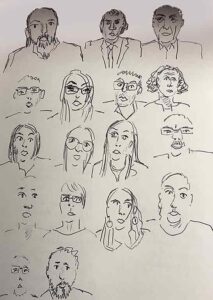Mary Fletcher

I am watching Question Time, which during the Covid crisis presents us with a wall of zoomed members of the public. I am trying to draw the speakers.
What strikes me is how very different men and women look. The men all wear a uniform of suit, shirt and tie if on the panel; those in the audience have a tiny bit more variation. None of them wear make-up.
The women are more colourfully dressed. Many of them are heavily made up with eyebrows equally heavily drawn on, sharply defined lipsticked mouths, and very darkly outlined and shadowed eyes. Many have obviously dyed hair in bright blonde or dark red shades with luxuriously long curly tresses or perfectly straightened bobs. Most have covered their skin with a layer of concealing foundation with highlighted cheekbones.
What does this say about our society? Men are very restricted in what they wear, very natural looking in their faces. Their hair and beards are mostly trimmed and groomed.
Women are often like painted dolls, very contrived, very image-conscious, ears ringed, with degrees of flamboyant disguise, presumably thinking to make themselves attractive.
These conventions are so very compelling. This at a time when more people are rejecting the sex they were born into to adopt an alternative gender identity. If there was a good deal more leeway for variation in how a man or a woman can present themselves in public, would it be better and less restricting? Would there be fewer people feeling drawn to alter their gender?
Maybe lipstick will be less used when we are wearing masks. Eyes are more prominent. Haircuts are more scarce.
But the grip of our culture shows little sign of relaxing its gender-role conformity.
Volume 35 no 4 March/April 2021
